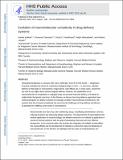Evolution of macromolecular complexity in drug delivery systems
Author(s)
Kakkar, Ashok; Traverso, Giovanni; Farokhzad, Omid C; Weissleder, Ralph; Langer, Robert
DownloadAccepted version (1.298Mb)
Terms of use
Metadata
Show full item recordAbstract
© 2017 Macmillan Publishers Limited. Designing therapeutics is a process with many challenges. Even if the first hurdle-designing a drug that modulates the action of a particular biological target in vitro-is overcome, selective delivery to that target in vivo presents a major barrier. Side-effects can, in many cases, result from the need to use higher doses without targeted delivery. However, the established use of macromolecules to encapsulate or conjugate drugs can provide improved delivery, and stands to enable better therapeutic outcomes. In this Review, we discuss how drug delivery approaches have evolved alongside our ability to prepare increasingly complex macromolecular architectures. We examine how this increased complexity has overcome the challenges of drug delivery and discuss its potential for fulfilling unmet needs in nanomedicine.
Date issued
2017Department
Harvard University--MIT Division of Health Sciences and Technology; Massachusetts Institute of Technology. Department of Chemical Engineering; Koch Institute for Integrative Cancer Research at MITJournal
Nature Reviews Chemistry
Publisher
Springer Science and Business Media LLC